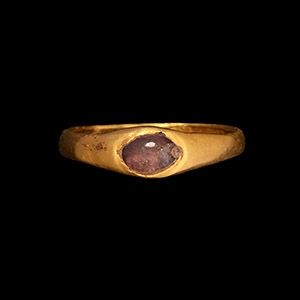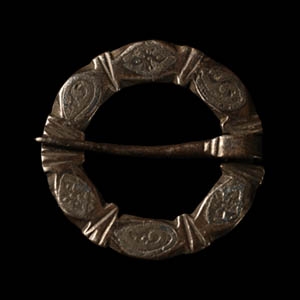Home > Auctions > 26 November - 1 December 2024
Ancient Art, Antiquities, Natural History & Coins
Found UK.
From the private collection of the late Alexander Cotton, Hampshire, UK.
Cf. MacGregor, A. & Bolick, E., A Summary Catalogue of the Anglo-Saxon Collections (Non-Ferrous Metals), Oxford, 1993, items 25.6-8.
Found North Yorkshire, UK.
The style of decoration is typical of Hiberno-Saxon metalwork associated with the influence of Irish missionaries in England.
Private collection formed in Europe in the 1980s.
Westminster collection, central London, UK.
Acquired on the European art market since the early 2000s.
From the private Northern Ireland collection of R.M.
Cf. Hammond, B., British Artefacts vol.3 - Late Saxon, Late Viking & Norman, Witham, 2013, items 1.1.1-h, 1.1.1-i.
Found near Cambridge, Cambridgeshire, UK.
From an old private collection of Norfolk, UK, gentleman, formed since 1998.
Accompanied by a copy of UK Detector Finds Database (UKDFD) report no.57990.
Cf. Webster, L. & Backhouse, J., The Making of England. Anglo-Saxon Art and Culture AD 600-900, London, 1991, item 184, for full set.
Dress pins of this type were worn in sets of three connected with chains or thongs.
Found Kingsworthy, Winchester, Hampshire, UK, in 2017.
Accompanied by a copy of the Portable Antiquities Scheme report number BERK-DB4E15.
Accompanied by a copy of the article in The Searcher magazine, number 389, January 2019, where it is featured on the front cover.
This lot has been checked against the Interpol Database of stolen works of art and is accompanied by a search certificate number no.12439-225587.
Cf. Hammond, B., British Artefacts - volume 1. Early Anglo-Saxon, Witham, 2010, item 1.4.5-r; Raynor, K., The Rempstone Mount: Anglo Saxon and Viking Horned Man Images & Artefacts, Nottingham, 2010; Pollington, S., Kerr, L. & Hammond, B., Wayland's Work: Anglo-Saxon Art, Myth & Material Culture from the 4th to 7th century, Ely, 2010; Pestell, T., Paganism in Early Anglo-Saxon East Anglia in Heslop, T.A., Mellings, E.A. and Thofner, M., Icon? Art and Belief in Norfolk from Prehistory to the Present, Woodbridge, 2012, figs. 6(a,b).
The Searcher magazine, number 389, January 2019, where it features as the only item on the front cover and a two-page exclusive article by the finder, Caroline Fathers, on pp.14 & 15.
The headgear with bird-head terminals is restricted to the 6th-7th centuries in England, although there are parallels from the material culture of both Anglian England and southern Scandinavia at this time. A pair of comparable bird-helmeted human faces can be found on the reconstructed frontal plates on the helmet found in Mound 1 at Sutton Hoo (Suffolk) depicting dancing warriors, and the male face shown on a foil fragment recovered from the barrow at Caenby (Lincolnshire). Similar also is the figure on one of the dies found at Torslunda (Öland, Sweden) showing a male wearing a helmet with a pair of bird-headed horns. A long, triangular male face is shown on the vandyke designs on the foil horn mounts from the barrow at Taplow (Berkshire). A male figure wearing a helmet with horns and bird-head terminals is the central design on a long triangular buckle found in grave 95 at Finglesham (Kent), and also from Finglesham (grave 138) is a mount in the form of a long, triangular human head with vertical radiating bands from the top of the head, and two crescentic horns emerging from the crown, terminating in opposed birds’ heads which meet above. A similar mount was found at Rempstone (Nottinghamshire) and privately published in Raynor (2010) while others were found more recently at Attleborough (Norfolk) and Soberton (Hampshire, PAS ref. HAMP2432). A mount depicting a similar figure, showing the upper body with hands gripping spears, was published in Hammond (2010). The significance of the headgear has not been fully explored but the coincidence of the birds and the head recall the later myths of Oðinn and his bird messengers, and suggest that these mythic characters were familiar in early Anglo-Saxon England. Kevin Leahy, National Adviser, Early Medieval Metalwork of the PAS commented: "This striking mount is Early Anglo-Saxon and dates from the 6th to 7th century. Faces like this, wearing a horned headdress (or sporting horns of their own) are well known, appearing on some of the foils decorating the Sutton Hoo helmet, where the warriors carry swords and spears and appear to be dancing. A similar foil was found in a burial at Caenby, Lincolnshire and the horned warrior carrying two spears appears on a gold buckle from Finglesham, Kent. Horned warriors are not restricted to England and appear on a die for making foils found at Torslunda, Sweden, and on a die from Ayton in the Scottish Borders region. The question is: who do these mounts represent? It has been suggested that they depict the god Woden, one of whose attributes was a spear and that the birds' heads on the ends of the horns represent the the god's two ravens. However, these birds often have hooked eagles' beaks not the pointed beaks of ravens. We also see multiple depictions of the horned warrior on the same foil suggesting that it was not the god, although it is possible that the god's image was duplicated to emphasise his power. Woden is sometimes shown with only one eye as he gave up his other eye in exchange for wisdom. The two garnet-inlaid eyes seen here do not preclude the face being that of Woden but it would have been helpful if it had only one eye. Finally, what was this mount used for? Other examples like the one from Rempstone, Notts., has mounting pins on its back as does a mount from Finglesham, Kent. Many of the other mounts, however, lack any signs of a fixing. It is clear that the mount described here was attached to an iron object but we are left guessing what it was: a helmet or a buckle? Unless you find one still attached we are going to be left to wonder. Recorded and assessed by the Secretary of State’s Expert Adviser as an object of cultural interest. The RCEWA reviewed an export application and determined that it meets the third Waverley criterion, making it currently non-exportable.
with ArtAncient Ltd.
Private collection, London.
This lot has been checked against the Interpol Database of stolen works of art and is accompanied by a search certificate number no.12440-226863.
Cf. Hines, J., A New Corpus of Anglo-Saxon Great Square-Headed Brooches, London, 1997, items 11(a) Linton Heath for headplate, 17(b) Rothley, for foot.
The meaning of the 'facing mask' motif on the footplate is probably related to the profile masks frequently used in Style I art, where the 'pellet' eye is enclosed by an arched frame: the 'facing mask' repeats this motif to produce a pair of eyes in a doubled 'bow'. An element of visual 'riddling' is no doubt present: the design is neither one thing nor the other, but includes elements of both. Distribution of great square-headed brooches was initially concentrated along the valleys of the Rivers Trent, Thames and Severn, though it was later confined to the East Midlands and East Anglia (Hines, 1997, figs. 101, 102).
Found whilst searching with a metal detector in Ryedale, North Yorkshire, UK, on Sunday 5th February 2023 by Chris Ulliott.
Accompanied by a copy of the British Museum's Portable Antiquities Scheme report no.YORYM-59523A.
Accompanied by a handwritten signed letter from the finder explaining the circumstances of finding.
Accompanied by a copy of a signed Art Loss Register declaration no.S00236559, dated 18th September 2023, and an Interpol search certificate dated 3 October 2023.
This lot has been checked against the Interpol Database of stolen works of art and is accompanied by a search certificate number no.12441-225438.
Cf. Bruce-Mitford, R., The Sutton Hoo Ship-Burial. Vol. 3, London, 1983, p.206-239, for Sutton Hoo Mound 1 bowl; Bruce-Mitford, R., Ireland and the Hanging Bowls - A Review in Ryan, M., Ireland and Insular Art AD500-1200, Dublin, 1985, for discussion of types; Bruce-Mitford, R., The Corpus of Late Celtic Hanging-Bowls with An Account of the Bowls Found in Scandinavia, London, 2005, for full discussion of the type; Carver, M., Sutton Hoo. A Seventh Century Princely Burial Ground and its Context, London, 2005, p.261, for discussion of Sutton Hoo Mound 2 bowl and other finds.
Old bucket turns out to be 'excessively rare' Anglo-Saxon Bowl, BBC News, 1 September 2023 (copy included).
Hanging-bowls are high-status vessels with origins in the Roman period which continued in use only in Britain and Ireland. They appear in burial contexts which date them to the sixth to late seventh century. The form of this example is paralleled by the bowl from Hadleigh Road, Ipswich, Suffolk (British Museum accession number 1984,0103.9) which has a similar shape and kite-shaped escutcheons secured by three rivets (Bruce-Mitford, 2005, Corpus No. 86).
From the late Alison Barker collection, 1970-1990.
Cf. Chadour, A.B., Rings. The Alice and Louis Koch Collection, volume I, Leeds, 1994, item 622, for type.
Found by William Barker whilst searching with a metal detector on Friday 16th December 2016 in Oswestry, Shropshire, West Midlands, UK, declared as treasure and disclaimed by the crown with treasure case no.2017T0054.
Accompanied by a copy of the British Museum's Portable Antiquities Scheme (PAS) report no.HESH-5E23E3.
Accompanied by the original Shropshire Museum Service object entry receipt.
Accompanied by a copy of The Searcher Magazine article where it is published.
The Searcher Magazine, When is a 'Hot Rock' not a 'Hot Rock', no.379, March 2017, p.10, for an article on the circumstances of finding of this ring. Exhibited at the Harwich Museum, Harwich, Essex, UK, 11th September-2nd December 2024; accompanied by a copy of a photograph of the artefacts on display.
From the late Alison Barker collection, 1970-1990.
Cf. PAS-804C91/2002 T248, a similar ring also dated to the 13th century; The V&A Museum, accession number 65-1871, for similar.
Acquired in the 1980s.
From the collection of a London antiquarian.
Cf. Egan, G. & Pritchard, F., Dress Accessories 1150-1450, London, 2002, item 1326, for type.
An unusually fine example in silver; the bulk of these brooches are of lead-tin or copper-tin alloy.
265 - 276 of 3419 LOTS


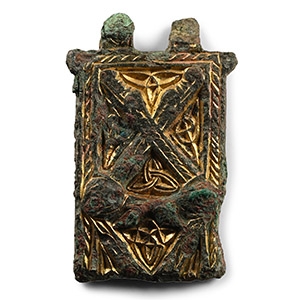
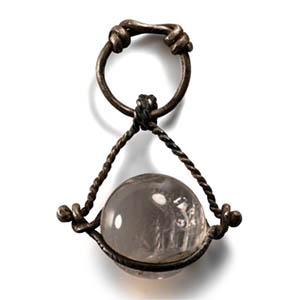
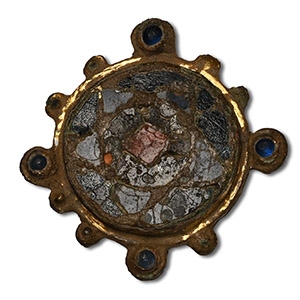
.jpg)

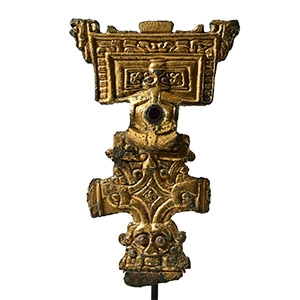
.jpg)

